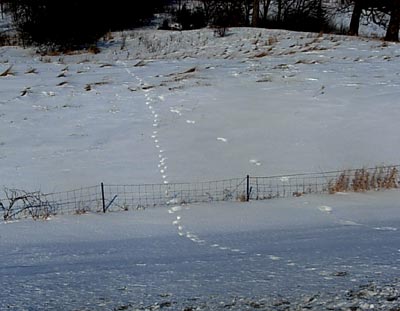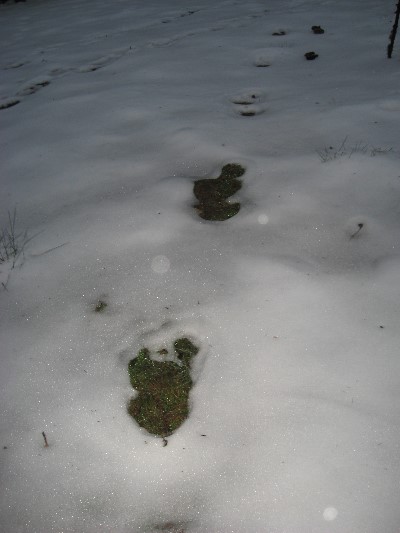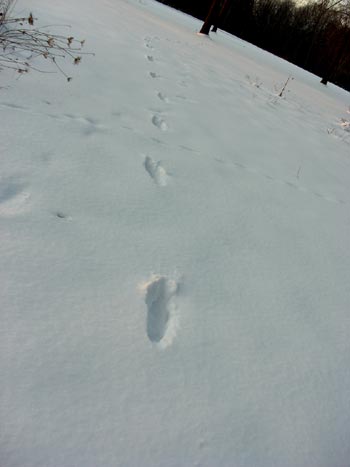|
The clickable points on the map above show the locations of possible
snow track finds during the winter of 2008/09. Click the letters
to see the photos, and descriptions, along with the links to the
relevant discussion
forum threads.
The use of lettered markers is not meant to suggest that
a single sasquatch progressed across the continent during the winter.
Many of these tracks were made/found at roughly the same time. They
are definitely not made by the same animal or track-maker.
 |
|
This photo from Wisconisn continues to astound people. The snow was 18 inches deep.
The larger tracks on the right were not made by a coyote or rabbit leaping through the snow.
The tracks were made by a large sasquatch stepping through the snow, and stepping over the fence
in the process.
The sasquatch tracks intersect with a line of deer tracks. The sasquatch was probably trying
to catch up to the deer. These Wisconsin photos show what many
witnesses have described in the past -- a tall sasquatch easily
stepping over a barbed wire fence without even slowing
down. The sasquatch that made these tracks is likely 8-9 feet
tall.
Click the image for more information and to find a larger
version.
|
This is useful knowledge. Canadians and Americans need to become
familiar with authentic sasquatch snow tracks, especially while
there is still snow on the ground in many parts of the continent.
With this in mind, the decision was made to release a gallery of
track photos from recent weeks before many more details and analyses
could be accumulated. Some initial assumptions may be corrected
in time regarding some of these track finds.
A few issues naturally arise when presenting a collection of snow
tracks photos: 1) How can we be so sure they not all fakes? 2) How
can we be sure they are not misidentified animal tracks or misidentified
human tracks? 3) What is significance of snow tracks of sasquatches?
Though we cannot be sure that all of them are authentic sasquatch
tracks, we are indeed very confident that some of them are
authentic sasquatch tracks. Along with the tracks that we strongly
suspect are authentic, we've also included some images that may
not show authentic tracks, to show some of the differences.
For example, there is a set of photos taken north of Seattle (look
for the red icon on the map), showing tracks that were faked. The
tracks found in Ontario, Canada (shown with the yellow icon) are
still undetermined because of how much they were degraded, but they
may be the impressions of a rabbit hopping through the snow. The
tracks found in North Dakota may be existing compressions of snow
that were modified to look like a large foot -- partially faked.
The photos did not all come from one source. Some of the tracks
were found by our own investigators in the field. Others came from
random people. The photos from Wisconsin were taken two days after
a daylight road-crossing sighting at that spot. We are very confident
in those tracks, and well as the tracks from SE OH and those from
Puget Sound, Washington. Those three can be regarded as standards
to which all others can be compared.
 |
| Authentic sasquatch tracks found by Derek Randles in the Puget
Sound region of western Washington State, showing the classic
long stride "high-wire" pattern. Click the image for
more information. |
The Puget Sound tracks and NE Ohio (Portage County) tracks were
obtained on private properties where activity had been previously
reported. The activity in Puget Sound is ongoing.
|
|
As for our specific techniques and criteria for distinguishing fakes
from authentic tracks ... that touchy issue deserves a separate
page.
The next issue, regarding the potential for honest misidentification,
is addressed (or shall be) on the individual pages about the tracks.
More details and analysis in this regard will be fleshed out in
the course of the Q&A on the relevant public forum threads.
The investigators/photographers will take questions in those threads.
The third issue, regarding the significance of snow tracks, can
be summarized on this page.
The Relevance to Migration
Many people ask and wonder whether these animals migrate with the
seasons, moving from the northern latitudes to the southern latitudes
to avoid the snowy winters. No evidence, annecdotal or otherwise,
suggests this pattern of seasonal migration. Whereas photos of snow
tracks in the northern latitudes deep into winter suggest that the
populations in those latitudes remain there throughout the year.
There is annecdotal data to suggest a pattern of elevation migration
with the seasons in mountainous regions, but elevation migration
would usually not take them out of the same county, or cluster of
counties.
The Relevance
to Hibernation
Many people ask and wonder whether they hibernate during the winter
in northern latitudes, like bears. There has never been any evidence,
annecdotal or otherwise, to suggest they hibernate through the winter.
Whereas photos of snow tracks in the northern latitudes deep into
winter, along with dozens of other similar track finds in the past,
in the snow, that were not photographed, suggest they do not hibernate
like bears.
Regarding
Public Awareness
Canadians and Americans should be on the look out for snow tracks
like these in areas of previous sightings. Sasquatches will often
cross roads and highways in the winter as the follow herds of deer
and elk, but most people won't pay attention to their tracks as
they approach roads, because the distinguishing characteristics,
such as the size and stride of the tracks, cannot be easily
discerned from a distance, especially while driving. If seen only
from a distance one could easily assume they are merely human tracks.
If you find what appears to be snow tracks of sasquatches, please
photograph them with a digital camaera. Before sending those photos
to us as attachments, please send a brief email to ContactUs@BFRO.net
to let us know that you have photos to send to us. If you have a
lot of photos to send us then we may have an alternate email address
for you to use.
Finding authentic sasquatch tracks in the snow is a unique, breathtaking
experience. If you are ever so lucky, the scene will make your hair
stand on end, as if your whole body knows that you cannot get away
from this animal if it pursues you. Full grown sasquatches are large,
swift, powerful apes that can easily overtake you and subdue you
if they are so inclined. The fact that they don't do this (have
only been known to do this in few cases where people have shot at
them), should provide some comfort to people who may come across
these types of tracks in remote areas.
Sasquatches won't hurt you or your children, even though they could,
provided that you do not shoot at them. If you shoot guns at them,
all bets are off in terms of how they might respond.
 |
|
Likely authentic tracks from Portage County,
northeasten Ohio. Click the image for more information.
|
Tracks in snow are more photogenic than tracks in almost any other
type of soil condition, but they can degrade quickly. For that reason,
if you live in a rural area which has a history of sighting reports,
please consider keeping a small digital camera in your vehicle glove
compartment at all times, just in case.
Many people have told us about spotting tracks like these in snow
while driving down rural highways, but they were unable to photograph
them because they didn't have a camera in the vehicle. Before this
year, most people didn't carry a camera all the time.
Decent quality digital cameras have become so small and inexpensive
that many people now own more than one -- mainly because so many
are received as gifts nowadays. During the Christmas of 2008
alone, hundreds of thousands of people received compact digital
cameras as gifts in Canada and America.
If you have more than one digital camera, please keep one in your
car. All of these historically important photos were shot with pocket
size digital cameras.
|





















